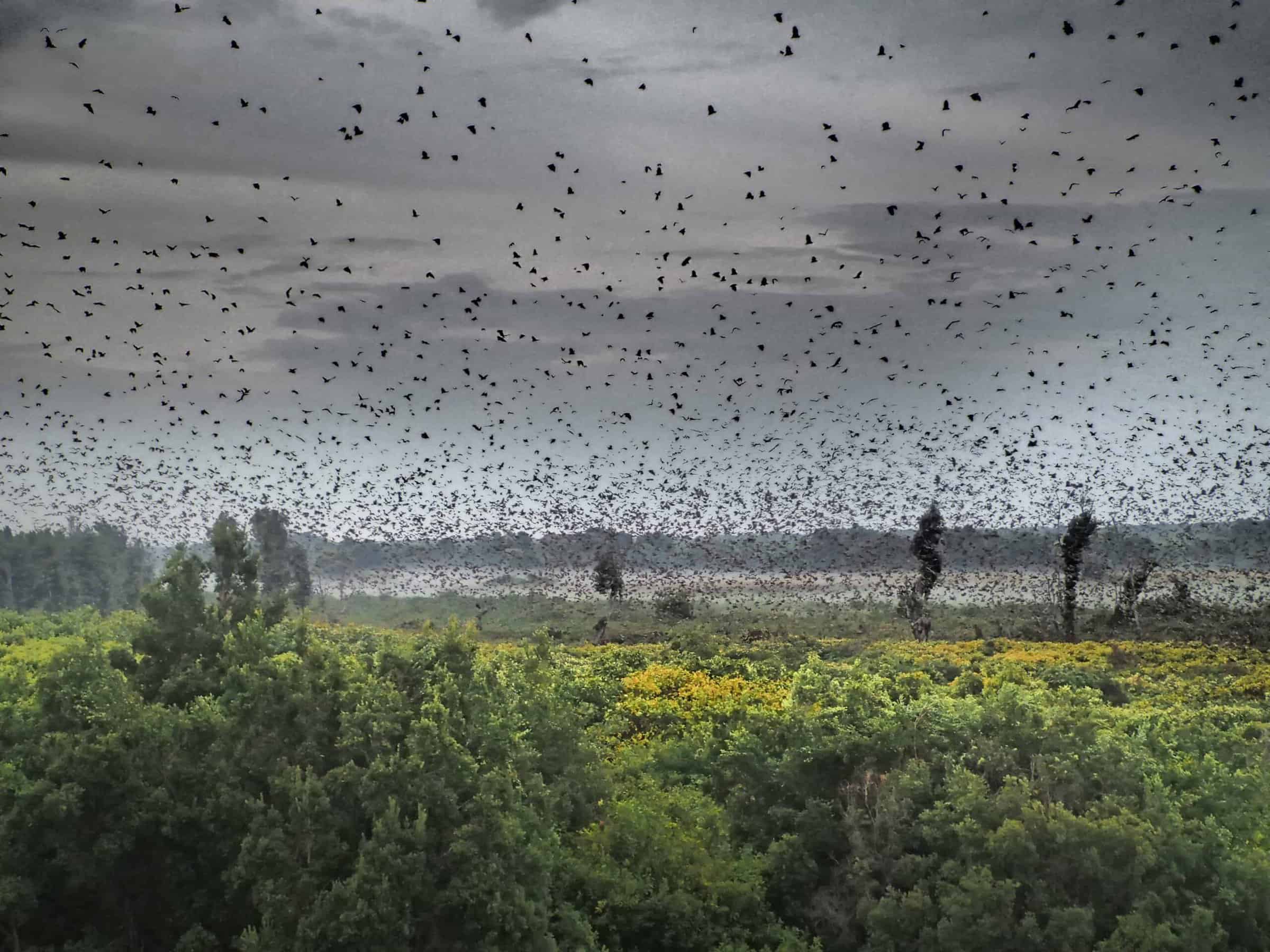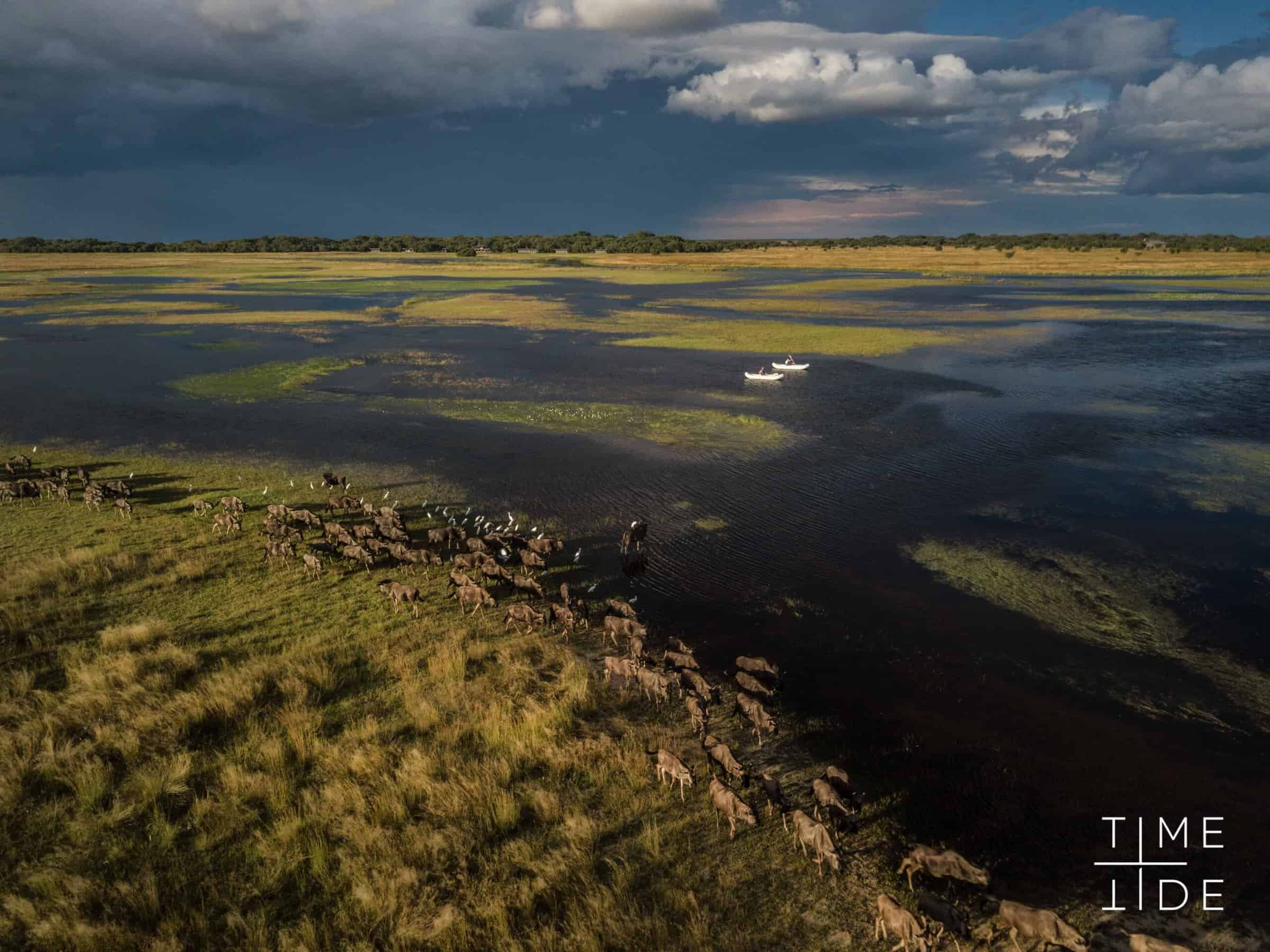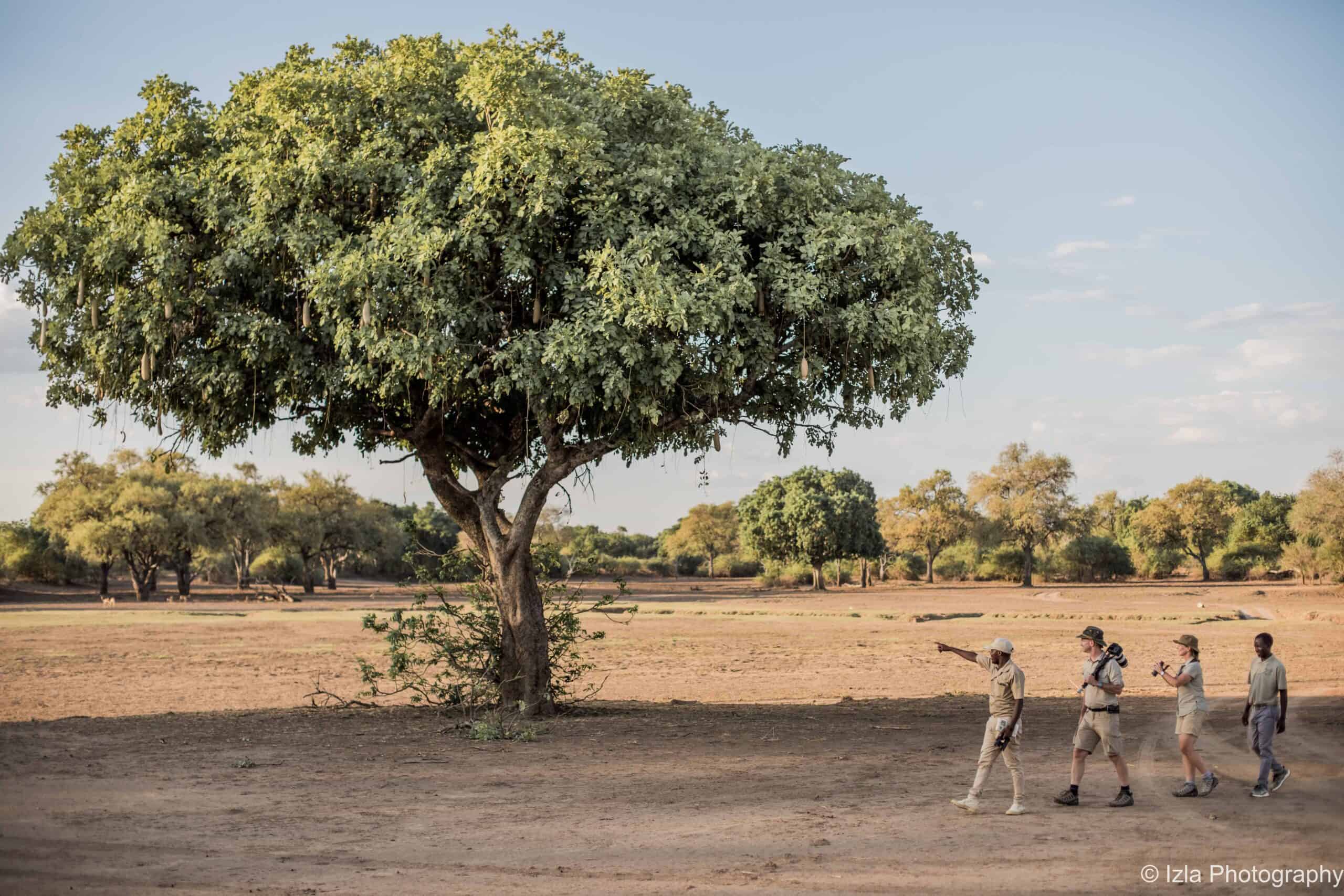Zambia has an impressive number of conservation areas, including 21 national parks and 36 game management areas (considered buffer zones between protected and developed zones), These reserves cover roughly 31% of the country’s land mass.
Apart from offering some of the best wildlife viewing in the world Zambia is also home to the Victoria Falls, one of the 7 Natural Wonders of the World along with dozens of beautiful waterfalls.
We’ve drawn up a summary of the 21 national parks of Zambia, and we hope that this guide will help you in compiling your bucket list of what to do on your next visit to our beautiful country. While some can undoubtedly be ignored, some others are well worth a visit especially if you want to explore the most remote parts of the country.

A to Z List of the 21 National Parks of Zambia
- Blue Lagoon National Park — 120km west of Lusaka, Blue Lagoon is on the north side of the Kafue River and offers excellent birding. It is subject to floods and rarely sees any tourist due to limited infrastructure and difficult access.
- Isangano National Park — This 840 km² national park founded in 1972 lies east of Lake Bangweulu, and subject to similar seasonal floods. But it lacks wildlife and is not worthy of a visit.
- Kafue National Park — One of the worlds largest national parks the Kafue NP was established in 1924 and is well known around the world for its amazing animal population. It is worth a trip to Zambia, in combination with South Luangwa, or even on its own.

Kafue NP by Jeffery & McKeith - Kasanka National Park —Kasanka NP is one of Zambia’s smallest parks (only 390 km²) but it is home to the world’s largest bat migration from October to November when close to 10 million African straw-coloured fruit bats visit the park.

Kasanka Bat Migration by ©Katie Siedel - Lavushi Manda National Park — This park offers great scenery with undulating landscapes (the peak of the Lavushi Hills reaches 1800 m) and waterfalls. It is home to an interesting birdlife although mammal numbers have been declining. Great for hiking, it is also possible to have some game drives/walks and some fishing arranged.
- Liuwa Plain National Park — This area had been recognized as a wildlife for over a century although it was mostly used as hunting ground for the Lozi King. It has now become one of the most captivating parks in the area, especially for its huge herds of wildebeest and their so-called migration.

Liuwa Plains by Time + Tide - Lochinvar National Park — Well known for its bird life and Kafue Lechwe this park is very similar to Blue Lagoon National Park on the other side of the Kafue. There are also a few hot springs and some unique curiosities.
- Lower Zambezi National Park — covering only a small part of the Lower Zambezi Valley which stretches from the Lake Kariba (most specifically its dam) to the border with Mozambique, this park shares the Zambezi River with Zimbabwe and hosts a great diversity of wildlife. It is famous for its water-based safaris allowing you to get quite close to grazing elephants.

Lower Zambezi by Chiawa Safaris - Luambe National Park — One of the oldest conservation areas in Zambia, the Luambe NP is a very small area (only 254 km²) tucked between South and North Luangwa National Park, with similar eco-systems.
- Lukusuzi National Park — Located on the eastern side of the Luangwa Valley, this park is still undeveloped, without any facilities and the quantity of wildlife is basically unknown.
- Lusaka National Park — This is Zambia’s youngest park, unveiled in 2015, and the closest to the country’s capital as it lies only 15km away. It is popular with locals for a day or weekend trip.
- Lusenga Plain National Park — This park features three very beautiful falls, and lovely walking opportunities. But very little wildlife although animals have been reintroduced to since 2007 but without any infrastructure.
- Mosi-oa-Tunya National Park (Victoria Falls) — Home of the Victoria Falls, Mosi-oa-Tunya translates to “the smoke that thunders”. The park has been extended along the Zambezi River (up and down river), and is home to a small population of heavily guarded white rhinos.
- Mweru Wantipa National Park — Another park with potential for redevelopment. Mweru Wantipa is mostly made-up of a lake and swampland similar to Bangweulu Wetlands.
- Ngonye Falls National Park – this area rarely appears on the official list however it was registered as national park in 2009. It is home to the spectacular Ngonye Falls (often called Sioma Falls) and an exciting destination for adventurous travelers.
- North Luangwa National Park — An amazing opportunity to experience Africa as it was. This wild and untouched area is one you won’t want to miss – especially for bush walks, and can be easily combined with an extended safari in South Luangwa National Park.
- Nsumbu National Park (also known as Sumbu) — Located in the Northern tip of Zambia this national park, which includes a small part of Lake Tanganyika, seems to have a promising future and already offers game drives, guided walks and birding, and excellent fishing on the lake.
- Nyika Plateau National Park — An extension to the national park on the Malawi side this park is well known for its scenery and vegetation and offers excellent hiking and some unusual wildlife.
- Sioma Ngwezi National Park — Although largely ignored, this is the 3rd largest national park of Zambia, located in the south-west corner of Zambia (bordering Angola and Namibia’s Caprivi Strip), and should see something of a revival in the future.
- South Luangwa National Park — Probably one of the best known national parks of Zambia, it can pretend to a top ranking place on Africa’s best wildlife sanctuaries, with incredible wildlife densities and variety. South Luangwa is home to our three Kafunta Safaris properties: Kafunta River Lodge, Three Rivers Camp and Island Bush Camp.

South Luangwa Kafunta by Izla Photography - West Lunga National Park — Although it may see some improvement in the future, West Lunga National Park is mainly an overgrown reserve, generally depleted of its bigger game. Boat trips and fishing remain available on the river.
Further information on the noteworthy National Parks
1.) South Luangwa National Park
Nicknamed the Valley of the Leopard, South Luangwa is famous specifically for its high density of leopards but in fact the variety of game is absolutely spectacular.
The South Luangwa National Park is usually on top of everyone’s list when planning a trip to Zambia, and it’s not hard to tell why. With a sheer number of animals, amazing sunsets, and plenty of birdlige it has something for just about everyone.
South Luangwa’s is also popular for ‘walking safaris’, where they originated, and which are a must do if you ever visit.
Overall the park is home to over 60 animal species, and 400 species of birds. This makes it one of the most intense concentrations of wildlife in Zambia.
No trip to South Luangwa would be complete without a stay at Kafunta River Lodge of course. If you’re interested in visiting the South Luangwa or any other destination on this list, get in contact with us and we’d be more than happy to help.
Best Time to Visit
The rainy season in South Luangwa ends in late March, early April. This is a beautiful time to visit while everything is still green. It is also an amazing time for birdwatching as well. Sightings of species like the Saddle-billed Stork and the Grey Crowned Crane are common.
May to October is the dry season. The vegetation grows sparser and the game viewing becomes easier with animals concentrating near the remaining water of the Luangwa River.
Read our blog “When is the best time to visit Zambia” for more on this subject.
Park Highlights
- There are an estimated 50 hippos for every kilometer stretch of the Luangwa River. Finding a huge herd of them lounging in the water is not uncommon.
- A game drive is a great way to explore some of Africa’s highest concentrations of wildlife. In South Luangwa you can also do night drives to observe predators on the move.
- The African Wild Dog population has now been declared the highest in Zambia
2.) Kafue National Park
Imagine a national park the size of Wales.
Covering approximately 22,500 sq. kilometers of land, that’s how big Kafue National Park is. Largest in the country and second largest in the continent, most of this vast reserve remains inaccessible.
Kafue is also known for the sheer diversity of its wildlife, just like South Luangwa, although there will be a particular interest in searching for cheetahs, and roan, sable and lechwe antelopes.
Best Time to Visit
The most convenient time to visit is from June to October. The dry season is in full swing, and access is easier, as parts of the park can be quite flooded.
However, if you are willing to put up with roads and torrential rain, the park is spectacular during the wet season. During the months of November to April, Kafue turns into a lush, green paradise, but the choice of accommodation is very limited.
Park Highlights
- The Busunga Plains are home to one of the park’s most iconic birds. The Wattle Cranes nest in these floodplain regions of the park.
- With a bit of luck, you may spot a cheetah hunting in the open grasslands.
- Kafue NP is the only park in Zambia where you can have hot air balloon rides.
3.) Lower Zambezi National Park
The Lower Zambezi National Park has the hallmarks of a true African adventure: the slowly meandering Zambezi River, the rocky escarpments and some dense acacia forests.
Before being formally declared a national park, the Lower Zambezi was the private game reserve of Zambia’s president until 1983, which ironically helped retain the pristine beauty of this park. The actual Lower Zambezi Valley stretches from the Kariba Dam to the Mozembique border, and it has a formidable reputation for big game – specifically elephants and buffaloes.
Park Highlights
- Undeniably, canoeing is a popular activity on the slow moving Zambezi, and a great way to observe hippos and elephants.
- Game drives and bush walks will bring you in the denser forests to spot leopards and wild dogs.
- If you fancy fishing, most camps will have opportunities for catch & release activities.
4.) Mosi-oa-Tunya National Park
“The Smoke Which Thunders”
Mosi-oa-Tunya is the protected area that encompasses much of the land around the Victoria Falls but also upriver and downriver. The park gets its name from the thundering” smoke” created by the Falls themselves, the spray of water that rises as the Zambezi crashes down the gorge in full force.
In comparison to parks like Kafue, Mosi-oa-Tunya is tiny, covering an area of only 66 sq. kilometers. But what it lacks in size, it makes up for in spectacle. As home to the largest waterfall in the world, this tiny park is why many people travel to Zambia.
Best Time to Visit
The Zambezi River is at its greatest strength between February and April, making a visit of the Falls a (very) wet affair. May to July is probably the best time to see the falls without getting soaked. Later on in the year, the river will dry significantly and the falls will be less impressive – although they never dry out completely.
Park Highlights
- For the daredevils, there is the Victoria Falls Gorge Swing to try. A 95 m long swing, 120m high, with a freefall of 70 m- now that’s worth a lot of screams!
- Less adventurous, the birdwatching is extraordinary on the banks of the river.
- The park is home to a few white rhinos and their armed security protecting them at all times under the government’s mandate. Just catching sight of these rare animals in Zambia is a privilege.
Conclusion
Spectacular waterfalls, the expansive African bush, thriving marshes- the Zambian wildlife experience is unforgettable. Nature here is diverse, unpredictable, and always exciting.
From the remote Zambezi trails to the luxurious safaris of South Luangwa, Zambia is truly one of those unforgettable, once-in-a-lifetime places.
Sources:
Bradt’s Guide to Zambia by Chris McIntyre. Sixth edition.







